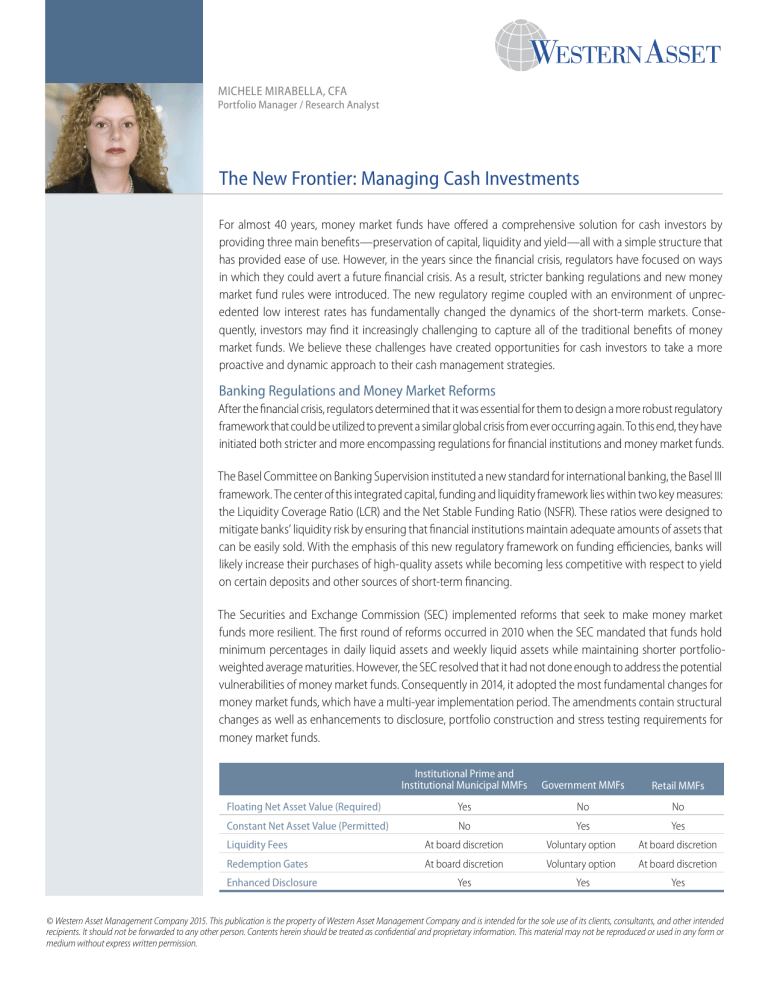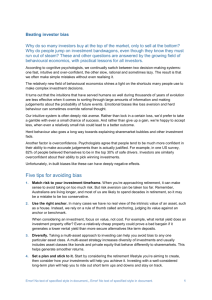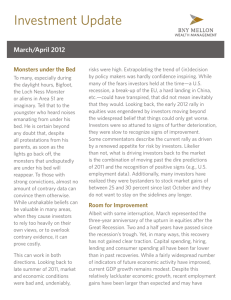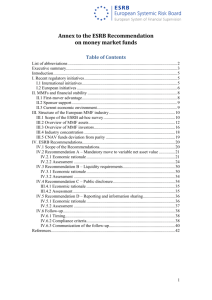The New Frontier: Managing Cash Investments

MICHELE MIRABELLA, CFA
Portfolio Manager / Research Analyst
The New Frontier: Managing Cash Investments
For almost 40 years, money market funds have offered a comprehensive solution for cash investors by providing three main benefits—preservation of capital, liquidity and yield—all with a simple structure that has provided ease of use. However, in the years since the financial crisis, regulators have focused on ways in which they could avert a future financial crisis. As a result, stricter banking regulations and new money market fund rules were introduced. The new regulatory regime coupled with an environment of unprecedented low interest rates has fundamentally changed the dynamics of the short-term markets. Consequently, investors may find it increasingly challenging to capture all of the traditional benefits of money market funds. We believe these challenges have created opportunities for cash investors to take a more proactive and dynamic approach to their cash management strategies.
Banking Regulations and Money Market Reforms
After the financial crisis, regulators determined that it was essential for them to design a more robust regulatory framework that could be utilized to prevent a similar global crisis from ever occurring again. To this end, they have initiated both stricter and more encompassing regulations for financial institutions and money market funds.
The Basel Committee on Banking Supervision instituted a new standard for international banking, the Basel III framework. The center of this integrated capital, funding and liquidity framework lies within two key measures: the Liquidity Coverage Ratio (LCR) and the Net Stable Funding Ratio (NSFR). These ratios were designed to mitigate banks’ liquidity risk by ensuring that financial institutions maintain adequate amounts of assets that can be easily sold. With the emphasis of this new regulatory framework on funding efficiencies, banks will likely increase their purchases of high-quality assets while becoming less competitive with respect to yield on certain deposits and other sources of short-term financing.
The Securities and Exchange Commission (SEC) implemented reforms that seek to make money market funds more resilient. The first round of reforms occurred in 2010 when the SEC mandated that funds hold minimum percentages in daily liquid assets and weekly liquid assets while maintaining shorter portfolioweighted average maturities. However, the SEC resolved that it had not done enough to address the potential vulnerabilities of money market funds. Consequently in 2014, it adopted the most fundamental changes for money market funds, which have a multi-year implementation period. The amendments contain structural changes as well as enhancements to disclosure, portfolio construction and stress testing requirements for money market funds.
Floating Net Asset Value (Required)
Constant Net Asset Value (Permitted)
Liquidity Fees
Redemption Gates
Enhanced Disclosure
Institutional Prime and
Institutional Municipal MMFs
Yes
No
At board discretion
At board discretion
Yes
Government MMFs
No
Yes
Voluntary option
Voluntary option
Yes
Retail MMFs
No
Yes
At board discretion
At board discretion
Yes
© Western Asset Management Company 2015. This publication is the property of Western Asset Management Company and is intended for the sole use of its clients, consultants, and other intended recipients. It should not be forwarded to any other person. Contents herein should be treated as confidential and proprietary information. This material may not be reproduced or used in any form or medium without express written permission.
The New Frontier: Managing Cash Investments
Western Asset
Further details are contained in our paper published in July 2014, “Money Market Funds: The SEC’s Long-
Awaited Rulemaking.”
As these post-crisis regulatory policies take effect, the collective consequences will take form and will be broadly felt throughout the market. To date, the market has experienced a reduction in the supply of shortdated bank debt since the NSFR encourages banks to hold longer duration funding, thereby reducing banks’ reliance on short-term funding. Additionally, requiring banks to hold higher quality assets with the intent of reducing risk should they need to generate cash by liquidating assets at “fire sale” prices, has created increased demand for high-quality assets. As mandated by the 2010 SEC reforms, the requirement for money market funds to maintain a minimum amount of liquid assets coupled with their overall shorter maturity profile has caused funds to increase their demand for shorter dated assets. At the same time that money market funds are required to hold a higher percentage in short-term debt, banks are being penalized for issuing debt with maturities of less than 30 days. These reforms have essentially created a supply/demand mismatch between the banks and money market funds, fundamentally changing the dynamics of the short-end of the market.
We believe these market dynamics have created an opportunity for investors to revisit their cash management strategies and to explore the many alternatives for cash investors.
Alternatives for Cash Investors
Between the regulatory overhaul and the unprecedented market conditions of today’s environment, a fundamental shift has occurred in the way investors think of “cash.” The historical approach of utilizing money market funds to provide a simple cash alternative by providing preservation of capital, liquidity and yield will be transformed in the near future. And while we still believe that money market funds will continue to provide investors many benefits, we think that cash investors should view this as an opportunity to take a more dynamic approach to their cash management strategies. By adopting a more efficient approach to managing risk and liquidity, cash investors can realign their cash needs to better meet their strategic objectives.
One of the initial steps in this process is to establish or carefully review existing investment policies. Investment policies create a roadmap for cash investors by containing specific information about risk tolerances and liquidity needs, as well as identifying parameters for achieving investment goals. Investment policies should be designed to be dynamic and broad in scope so that cash investors can have the flexibility to respond to market fluidity and changing cash needs.
To ensure preservation of capital while achieving optimal returns within a cash portfolio, it is important to conduct a thorough evaluation of future liquidity needs. Once this analysis is complete, cash investors may consider segmentation or cash bucketing. To clarify, cash can fall into a minimum of three distinct categories: operating cash, core cash and strategic cash. By allocating cash investments over multiple time horizons, investors may be able to achieve optimal returns by separating operational cash needs from longer horizon strategic needs. In the coming months, this simplistic approach may require additional precision as multiple strategies may need to be utilized for the deployment of operating cash. As a result of this thorough analysis, cash investors may be able to more efficiently allocate their short-term investments to better meet strategic objectives.
Historically, money market funds have been categorized as a single type of account. However, the SEC regulatory reforms have made this single categorization more complicated for cash investors. While Treasury and government money market funds are exempt from the structural reforms, institutional prime money market funds and institutional municipal money market funds will be fundamentally transformed. As the October
2016 implementation date for these structural reforms approaches, cash investors will need to recalibrate their approach to money market fund investing. Additional factors that will require evaluation include floating net asset valuation (NAV) versus constant NAV, same day settlement versus next day settlement, and the potential for liquidity fees and redemption gates.
2 February 2015
The New Frontier: Managing Cash Investments
Summary of Cash Alternatives for Institutional Investors
Investment Horizon
Objective
Strategy
Operating Cash
Government Non-Government
0 – 6 months 0 – 6 months
Liquidity and preservation of capital
Liquidity and preservation of capital
Treasury Money
Market Funds
Government Money
Market Funds
Prime Money
Market Funds
Municipal Money
Market Funds
Settlement
NAV
Liquidity Fees/
Redemption Gates
Rating
Same day settlement
(T+0)
Constant NAV
Voluntary option
AAA rating
Core Cash Strategic Cash
6 – 12 months
Enhanced return
>12 months
Maximize total return potential
Ultra Short Bond
Funds
Short Term Bond
Funds
Separate accounts Short Duration Municipal
Bond Funds
Separate accounts
Same day settlement
(T+0)
Next day settlement
(T+1)
Floating NAV Floating NAV
At board discretion
AAA rating
None
Funds may be rated
Next day settlement
(T+1)
Floating NAV
None
Funds may be rated
Conclusion
With the imminent structural changes to money market funds and the market-based consequences of regulatory reform, investors need to prepare for the future and rethink their cash management strategies. As investors gain a better understanding of the dynamics of this new environment, they will be better equipped to meet its challenges. Western Asset is committed to working with our clients to help them navigate this new frontier, helping to ensure that they are prepared to optimize their liquidity management strategies.
Past results are not indicative of future investment results. This publication is for informational purposes only and reflects the current opinions of Western Asset Management. Information contained herein is believed to be accurate, but cannot be guaranteed. Opinions represented are not intended as an offer or solicitation with respect to the purchase or sale of any security and are subject to change without notice. Statements in this material should not be considered investment advice. Employees and/or clients of Western Asset Management may have a position in the securities mentioned. This publication has been prepared without taking into account your objectives, financial situation or needs. Before acting on this information, you should consider its appropriateness having regard to your objectives, financial situation or needs. It is your responsibility to be aware of and observe the applicable laws and regulations of your country of residence.
Western Asset Management Company Distribuidora de Títulos e Valores Limitada is authorized and regulated by Comissão de Valores Mobiliários and Banco Central do Brasil. Western Asset Management
Company Pty Ltd ABN 41 117 767 923 is the holder of the Australian Financial Services Licence 303160. Western Asset Management Company Pte. Ltd. Co. Reg. No. 200007692R is a holder of a Capital Markets Services Licence for fund management and regulated by the Monetary Authority of Singapore. Western Asset Management Company Ltd is a registered financial instruments dealer whose business is investment advisory or agency business, investment management, and Type II Financial Instruments Dealing business with the registration number KLFB (FID) No. 427, and members of JIAA (membership number 011-01319) and JITA. Western Asset Management Company Limited (“WAMCL”) is authorized and regulated by the Financial Conduct Authority (“FCA”). In the UK this communication is a financial promotion solely intended for professional clients as defined in the FCA Handbook and has been approved by WAMCL.
Western Asset 3 February 2015









